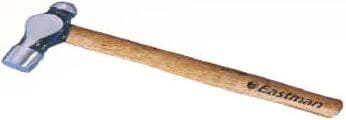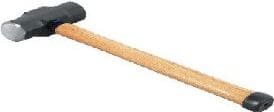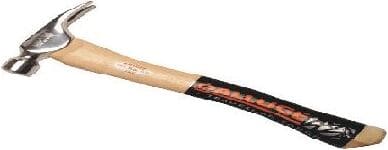A hammer is a handheld mechanical tool that finds application in everyday households. Hammers existence can be dated to as long as the stone age period where a stone fixed on wood or bone was used. Modern-day hammers consist of a weighted head crosswise at the front which is fixed to a long handle. The hammer can be swung in the arm which can deliver an impact on an object. There are different types of hammers available for different applications. Some common applications of the use of a hammer can be to drive nails into wood, to shape metal, or to break the rock. Hammers are used for driving, shaping, and breaking applications.
How a hammer is made?
The hammer head is typically made of steel or hard wooden block which is placed crosswise on the top of the handle rod. The handle is also known as a haft or helve can be made of wood or plastic. The hammer can vary in shapes size and structure depending on its usage. Some hammer heads may even have claws to pull out nails from wood.
Different Types of hammers
The list of different types of hammers is as follows
- Ball Peen hammer
- Brick hammer
- Claw hammer
- Drywall hammer
- Electrician hammer
- Framing hammer
- Sledge hammer
- Tack hammer
- Trim hammer
- Club Hammer
- Joiner’s Malletcarpenter’s mallet hammer
- Soft-faced hammer
- Veneer hammer
Ball Peen Hammer

This is also known as a machinist’s hammer. It can be identified by its two heads – a round one and the other is a flat one. Traditionally it is used in metalworking but it can also be used to strike punches and chisels. Also, it is used to round off edges on rivets.
Brick hammer

It is also known as a stonemason’s hammer. It has a flat face and consists of a chisel-like blade at the other end. These types of hammers can be used for breaking off pieces of brick, stone, rock or concrete. These are made with high-grade steel heads and have fibreglass or hardwood handles.
Claw hammer

It is one of the most used hammers. A claw hammer can be used to drive or pull nails from objects like wood or metal. It has a flat head with a claw attached to it. Unlike ball pein hammers claw hammers cannot be used for heavy hammering. These types of hammers are forged from softer steel alloys. High-grade claw hammers are generally made of fibreglass, which can range from 16 ounces to 20 ounces fibreglass nailing hammers.
Drywall hammer

These types of hammers have a serrated face with a small hatchet-shaped back region. It is also referred to as a plasterboard hammer. It is a lightweight straight peen hammer used to make cuttings in drywall. This is widely used in making space for electric outlets. It can also be used for driving or pulling nails into drywall.
Electrician hammer

It looks similar to claw hammers. It consists of an insulated fibreglass handle with a rubber-coated grip, which makes it safe to be used for electrical work. It has a rather longer striking face which allows contractors to do work in tight areas.
Framing hammer

It is a special type of claw hammer and it is twice as heavy as a claw hammer. The heavy weight of this hammer along with its waffled striking surface makes it easy for the contractors to drive nails quickly without slipping.
Sledge hammer

These types of hammers can be used for demolition work or drive stakes. These hammers have long handles which may range between nearly 2 feet to just over 3 feet. They can have heads that may weigh up to 20 pounds. They mostly have wooden handles but can also be made with fibreglass as well.
Tack hammer

These are also known as upholstery hammer or tack hammer. It is a lightweight tool commonly used for driving upholstery into furniture or surfaces. Mostly these hammers have two faces where the split side is magnetized to help users precisely place tacks.
Trim hammer

They are similar to tack hammer in size and weight. It is small and has a straight claw which can be used to drive trim nails without any damage to the work area.
Club Hammer

It is also sometimes called a Lump Hammer. It consists of a double-faced head which is useful for light demolition work or driving steel chisels and masonry nails. It can weigh upto 1135 g or 2½ lb which makes it best suited for domestic work. Handles are usually made of wood which can be Hickory or synthetic resin.
Joiner’s Malletcarpenter’s mallet hammer

These types of hammers are used for driving chisels or tapping wood joints together. These hammers are suited for applications where a metal-faced hammer would cause damage or bruising. The head of the hammer is slightly tapered which ensures correct contact with the work. Both the handle and head are made of wood which is usually Beech or Lignum Vitae.
Soft-faced hammer

These are available in various types with hard and soft rubber, plastic or copper faces etc. Some hammers also come with a choice of faces that can be interchanged. These are useful in striking materials such as chrome wing outs where a steel face can usually cause damage.
Veneer hammer

These types of hammers are used more like a squeegee than a hammer. The hot hide glue is applied to the surface and then the veneer is applied onto the glued surface. The hammer has a dull blade on one side of the head which is approximately three inches wide and a square-shaped face on the other side. This head of the hammer is connected to a standard handle like other regular hammers. The small square face of the hammer is designed in such a way that it pushes down exerting force to the blade side of the head. The blade of the hammer can be made from metal or wood. The important feature of its design is that the shape of the blade is somewhat tapered which permits the required force to be applied directly under the blade.
